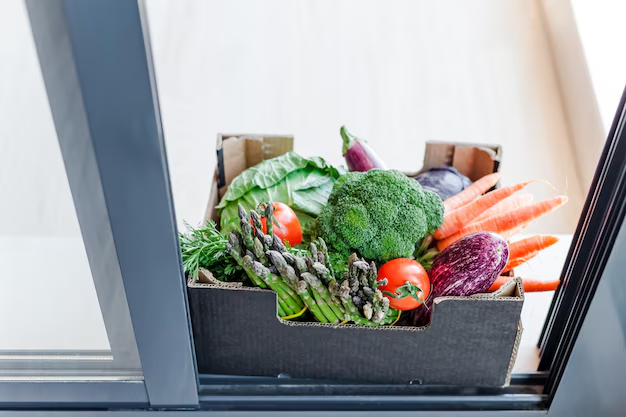The Ultimate Guide to Storing Cauliflower in the Refrigerator: Keep Your Vegetables Fresh and Crunchy
Cauliflower is celebrated in kitchens worldwide for its versatility and nutritional benefits. Whether you enjoy it roasted, riced, or raw, keeping your cauliflower fresh is key to maximizing its taste and texture. Storing cauliflower in the refrigerator might seem straightforward, yet there are tips and considerations that can make a big difference in its longevity and quality. Let's dive into the best ways to store cauliflower in your refrigerator, ensuring it stays fresh and ready whenever culinary inspiration strikes.
🥦 Why Choosing the Right Storage Method Matters
Cauliflower is a Nutritional Powerhouse
Rich in vitamins, fiber, and antioxidants, cauliflower deserves a place in your regular diet. However, improper storage can lead to premature wilting, loss of flavor, and reduced nutritional value. Understanding how to maintain the quality of cauliflower can enrich your meals and contribute positively to your health.
Preservation of Flavor and Texture
Cauliflower is most enjoyable when crisp and fresh. With the right storage methods, you can preserve its characteristic taste and satisfying crunch, making it a delightful addition to salads, stir-fries, and beyond.
Minimizing Food Waste
Stored correctly, cauliflower can last several weeks. Reducing spoilage extends its shelf life, minimizes waste, and ensures you're making the most of your grocery budget.
H2: How to Store Cauliflower in the Refrigerator
H3: Selecting the Right Cauliflower
Before diving into storage specifics, choosing high-quality cauliflower at the point of purchase is crucial:
- Opt for Firm, White Heads: A good cauliflower should be firm with a bright white color. Avoid brown spots or mushy areas.
- Check the Leaves: Fresh, green leaves are a good indicator of freshness.
- Test for Weight: Heavier heads usually mean they're fresh and packed with moisture.
H3: Pre-Storage Preparation
- Do Not Wash Until Use: Moisture promotes spoilage, so avoid washing cauliflower before storing it. Wait until you're ready to cook or serve it.
- Remove Excess Leaves: Leaves shield cauliflower but leaving a few outer layers intact can protect the head during storage.
H3: Best Practices for Storing Cauliflower
Once you've chosen your cauliflower, follow these steps for refrigeration:
Choose the Right Spot: The crisper drawer of your refrigerator is ideal. It's designed to maintain humidity, which helps keep vegetables fresh longer.
Use Proper Packaging:
- Plastic Bags: Store cauliflower in perforated plastic bags to allow some airflow.
- Reusable Produce Bags: An eco-friendly alternative, these bags provide a combination of moisture retention and breathability.
Allow Space: Don't overcrowd. Space ensures proper air circulation and reduces the risk of accidental bruising.
Keep Whole Until Needed: Cutting or separating cauliflower into florets increases exposure and speeds up spoilage.
H3: Extending Shelf Life
For longer storage times, blanch and freeze cauliflower:
- Blanching Process: Briefly boil florets for 3-5 minutes, plunge them into ice water, drain well, and then freeze. This process preserves texture and flavor.
H2: Additional Storage Considerations and Tips
Temperature and Humidity Matters
- Ideal Temperature: Store cauliflower at 32°F – 41°F, the common temperature range of a home refrigerator.
- Humidity: High humidity environments prevent drying and wilting.
What to Avoid
- Don’t Seal Tightly: Cauliflower needs to breathe, so avoid sealing it in airtight bags or containers.
- Avoid Ethylene Gas Producers: Don't store cauliflower near fruits like apples, bananas, or tomatoes, which release ethylene gas and accelerate spoilage.
📝 Quick Reference Cheat Sheet
Here's a quick overview of essential cauliflower storage tips:
- 🛒 Select Freshly: Firm, white heads with green leaves.
- 🚿 Wash Later: Do not wash until you're ready to use it.
- 🥗 Storage Method: Use perforated bags and place in the crisper drawer.
- 🥶 Freeze When Needed: Blanch and freeze for longer preservation.
- 🌡️ Temperature Control: Maintain between 32°F – 41°F.
- 🍌 Separate from Fruit: Keep away from ethylene-releasing fruits.
H2: Creative Ways to Use Keeping Fresh Cauliflower
Maintaining fresh cauliflower not only ensures quality but also unlocks its culinary potential. Here are some delicious ways to enjoy:
H3: Roast for a Nutty Flavor
Roasting enhances cauliflower’s natural sweetness. Toss with olive oil, salt, and pepper before baking at 400°F until tender.
H3: Rice for a Low-Carb Substitute
Grate cauliflower with a food processor for a rice alternative. Sauté with garlic and onions for added flavor.
H3: Incorporate into Soups and Stews
Cauliflower’s subtle flavor melds perfectly into creamy soups or hearty stews, adding nutritious bulk to the dish.
H3: Enjoy as a Raw Snack
Pair with hummus or dip for a refreshing, crunchy snack that's perfect for any time of the day.
Elevate Your Food Storage Skills
By adopting these simple storage techniques, you'll find that your cauliflower not only lasts longer but also tastes better, offering a delightful experience every time you cook. Freshness in your produce equates to a fresher approach to your meals, embracing both taste and health in each bite. Keep these insights at your fingertips and transform the way you store, preserve, and enjoy your cauliflower, ensuring every head becomes a centerpiece of your home cooking adventures. 🥦
